Using mind-Mapping as a transition from receptive to productive skills for second - degree learners
Mindmapping, as a powerful brainstorming tool, is gaining popularity in all fields of science. This article aims at suggesting various activities enclosed with explanations of how this useful utility can be applied for a smooth transition from receptive skills to productive skills while teaching English. As mind maps only date back to 1976, the article initially provides an overview into how to use them and how well they suit the group of grown-Up learners. The third part of the article introduces the researcher’s own organization of twelve academic themes throughout the learners’ course. The most important part of the article involves an analysis of various examples of classroom mind maps as they are combined with various activities in classroom settings of various levels throughout the course, highlighting the shifting from one receptive skill to the corresponding productive skill with groups of learners’ contributions to the maps. Last but not least, in the conclusion part, both the summary of the work and some recommendations would be presented about the challenges teachers may encounter and thus should expect during the implementation process
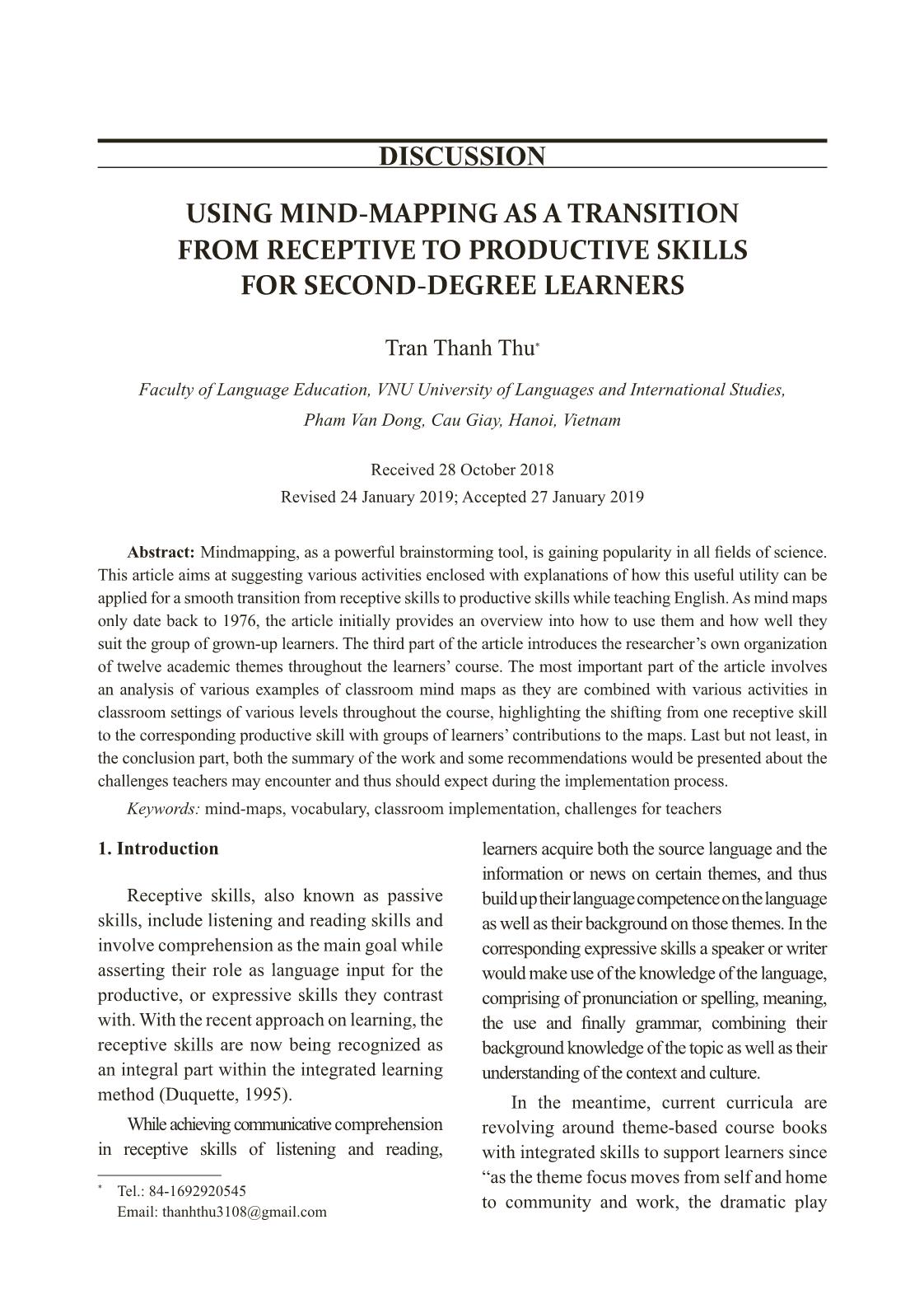
Trang 1
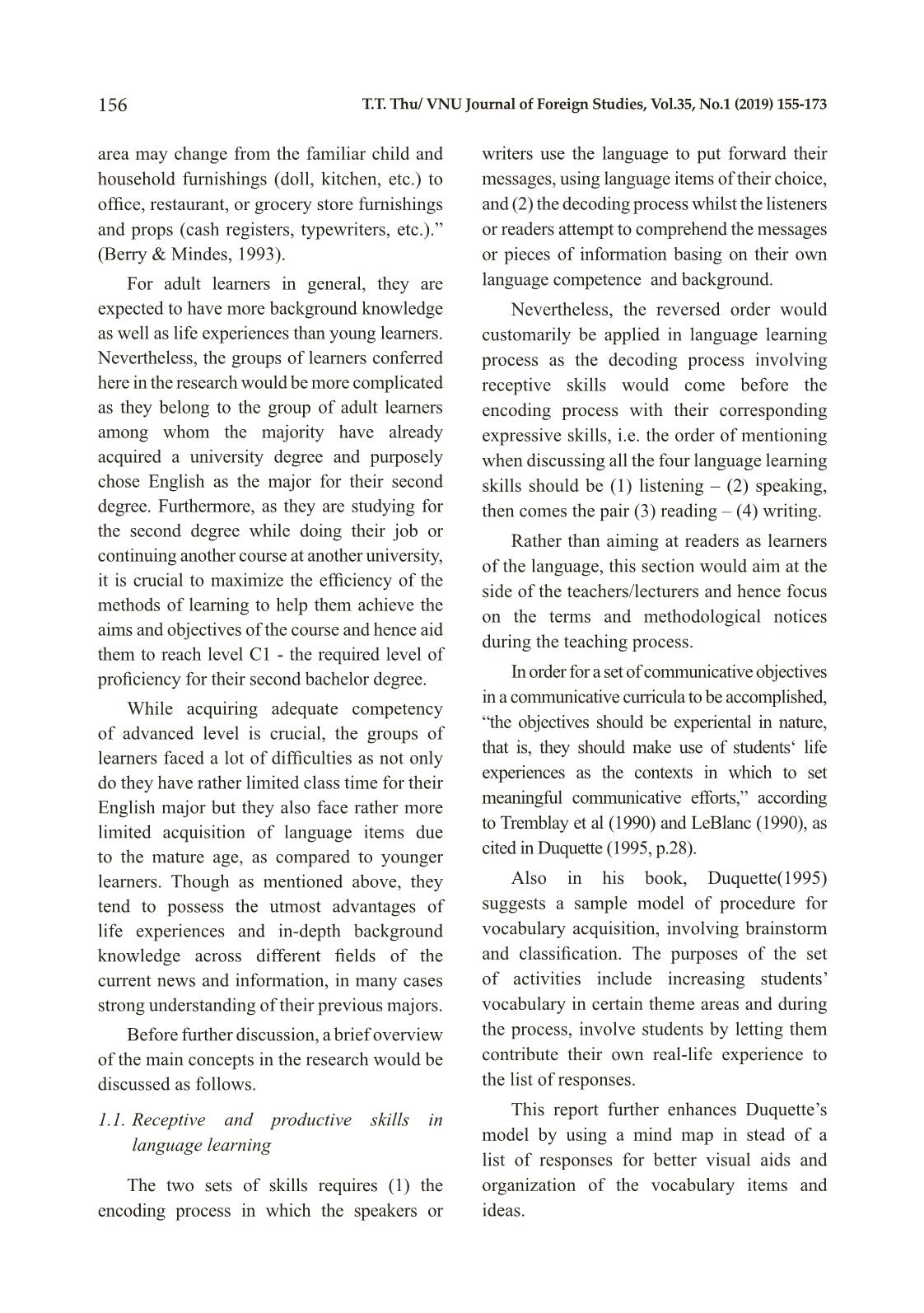
Trang 2
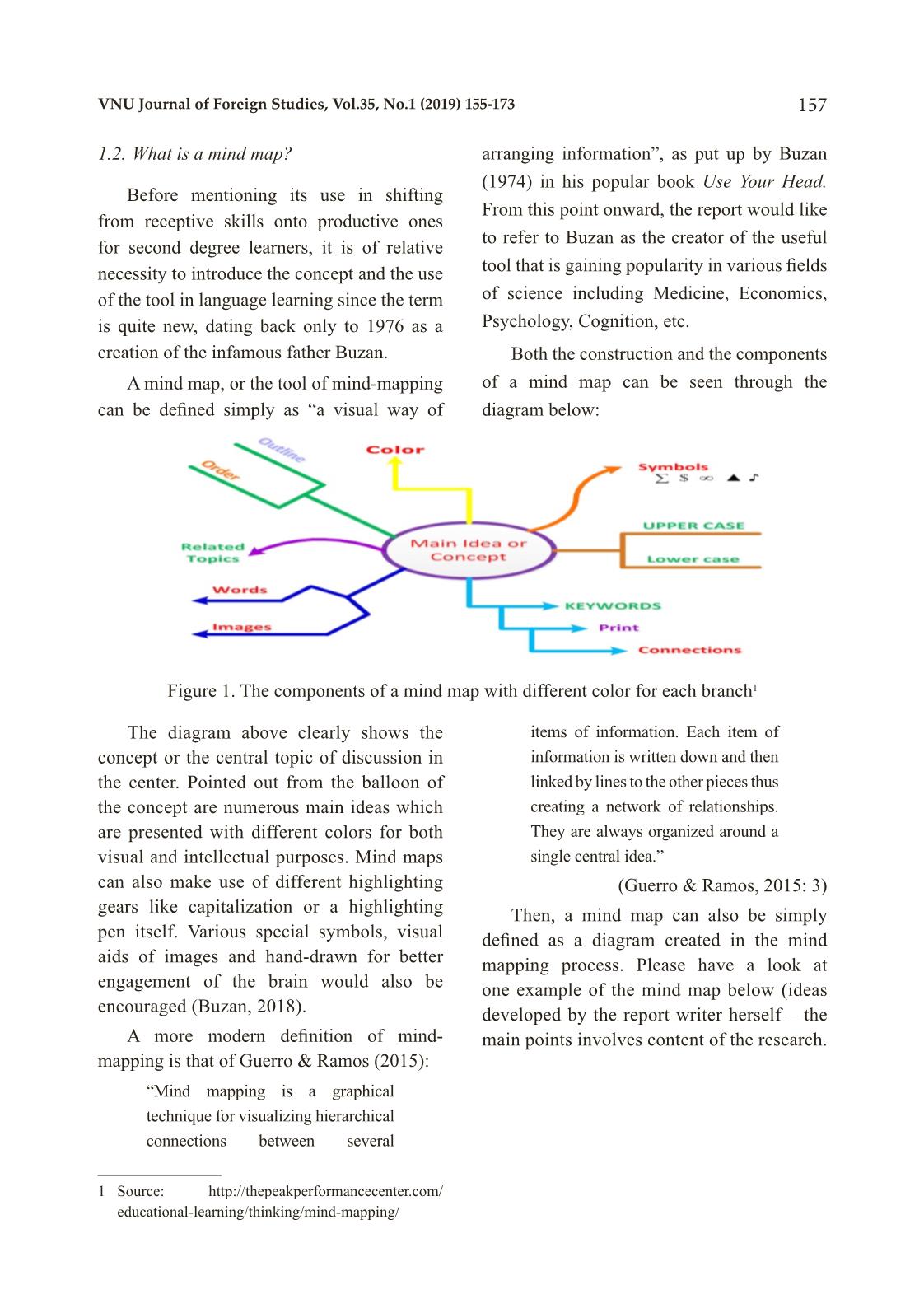
Trang 3
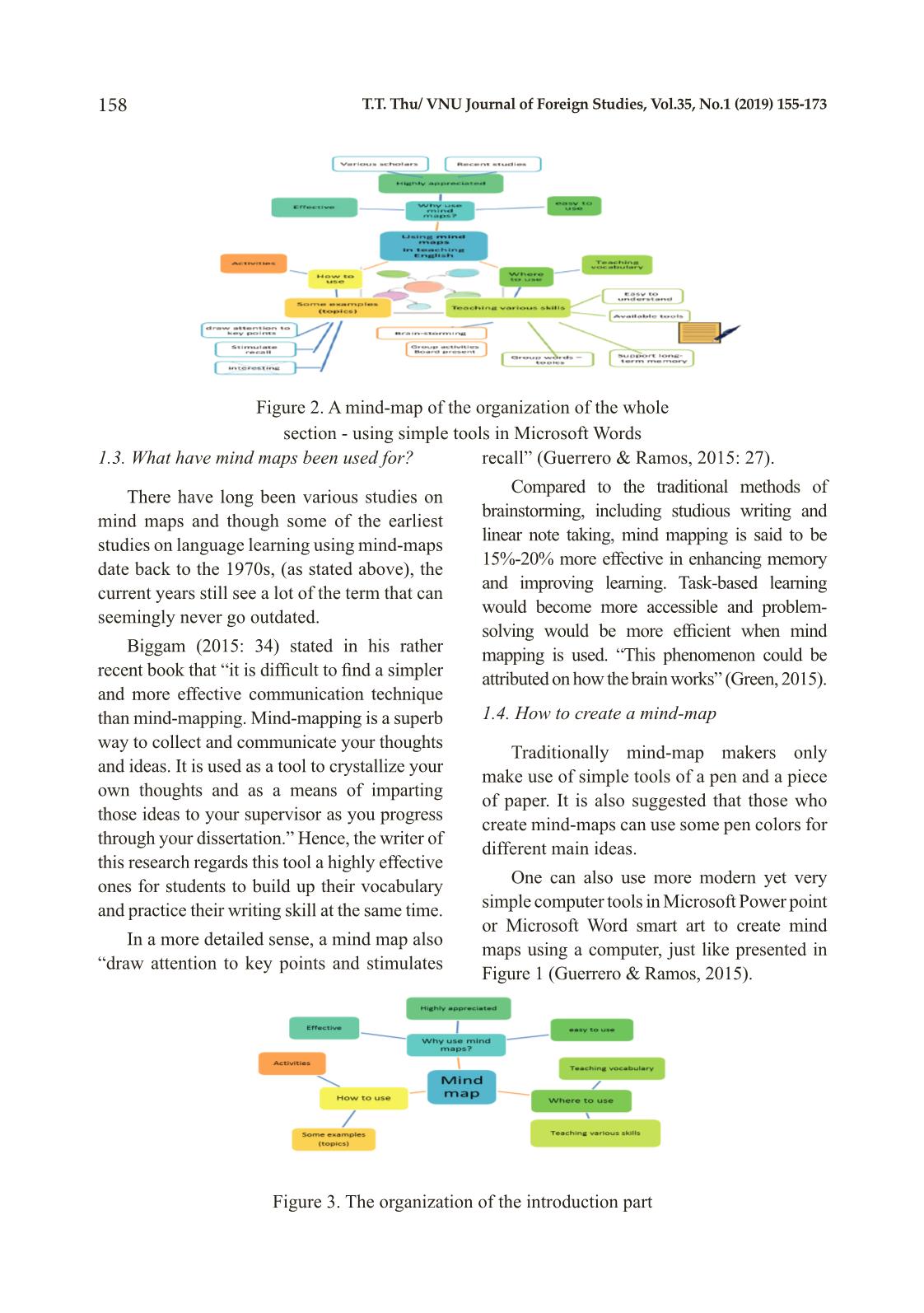
Trang 4
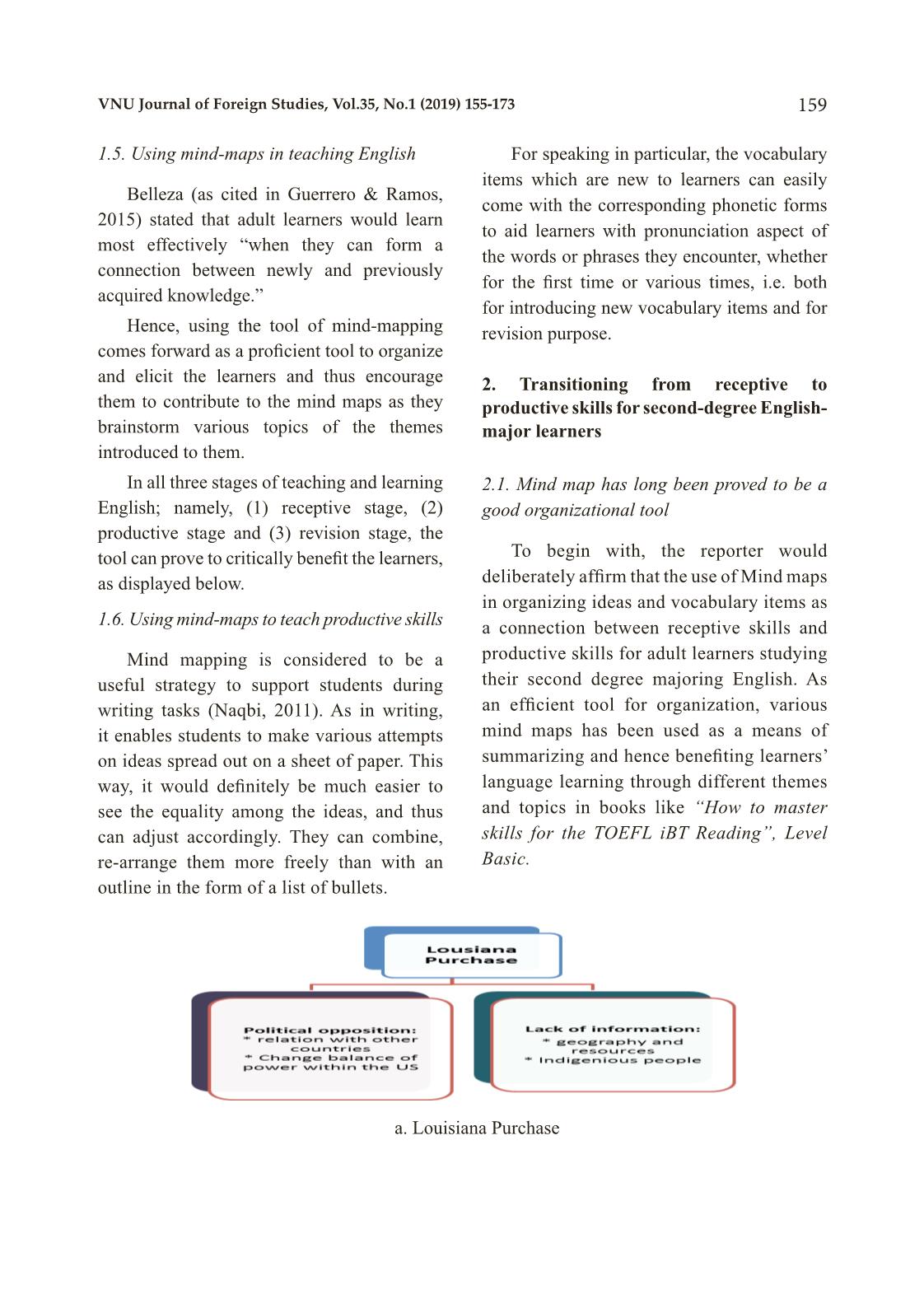
Trang 5
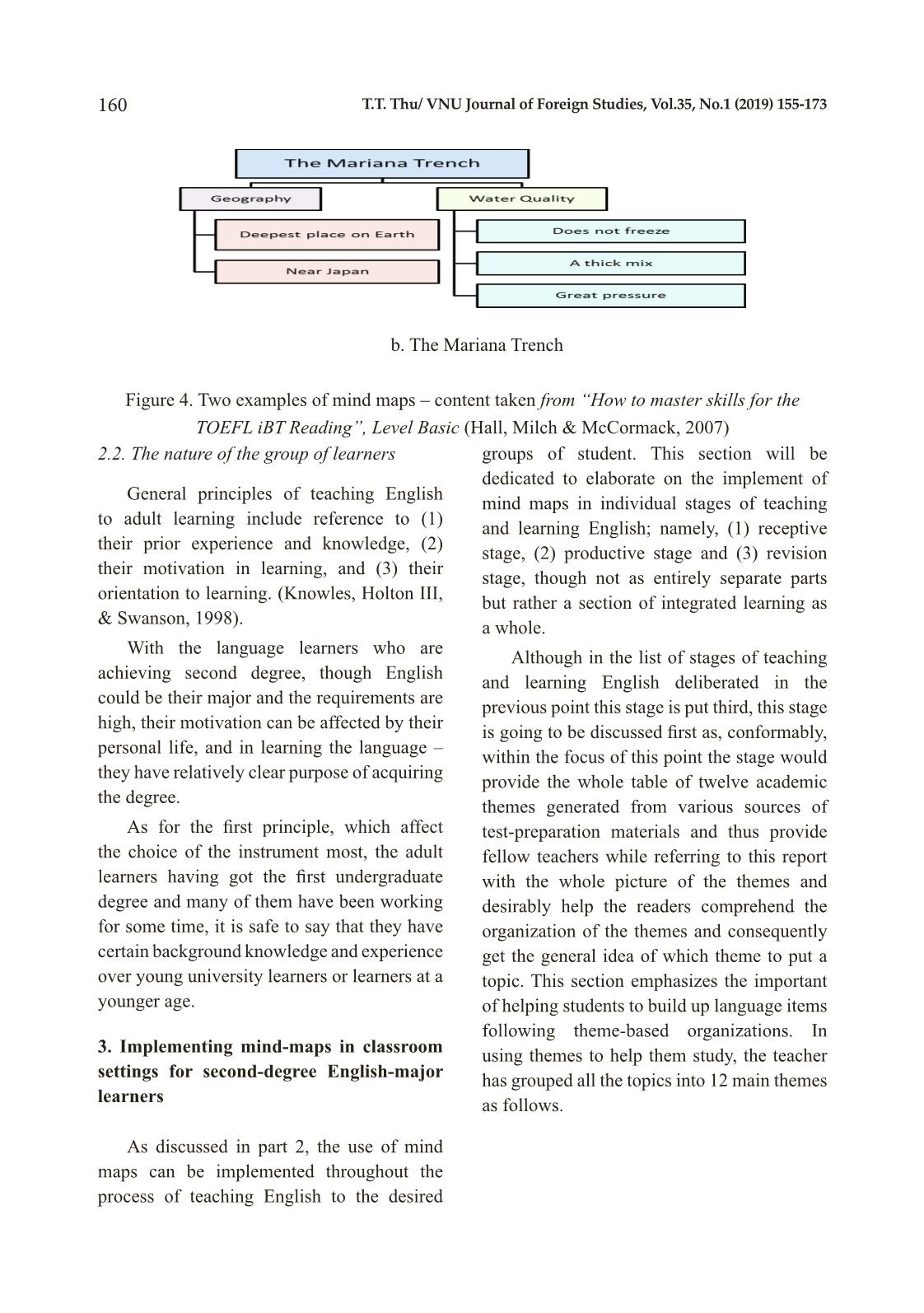
Trang 6
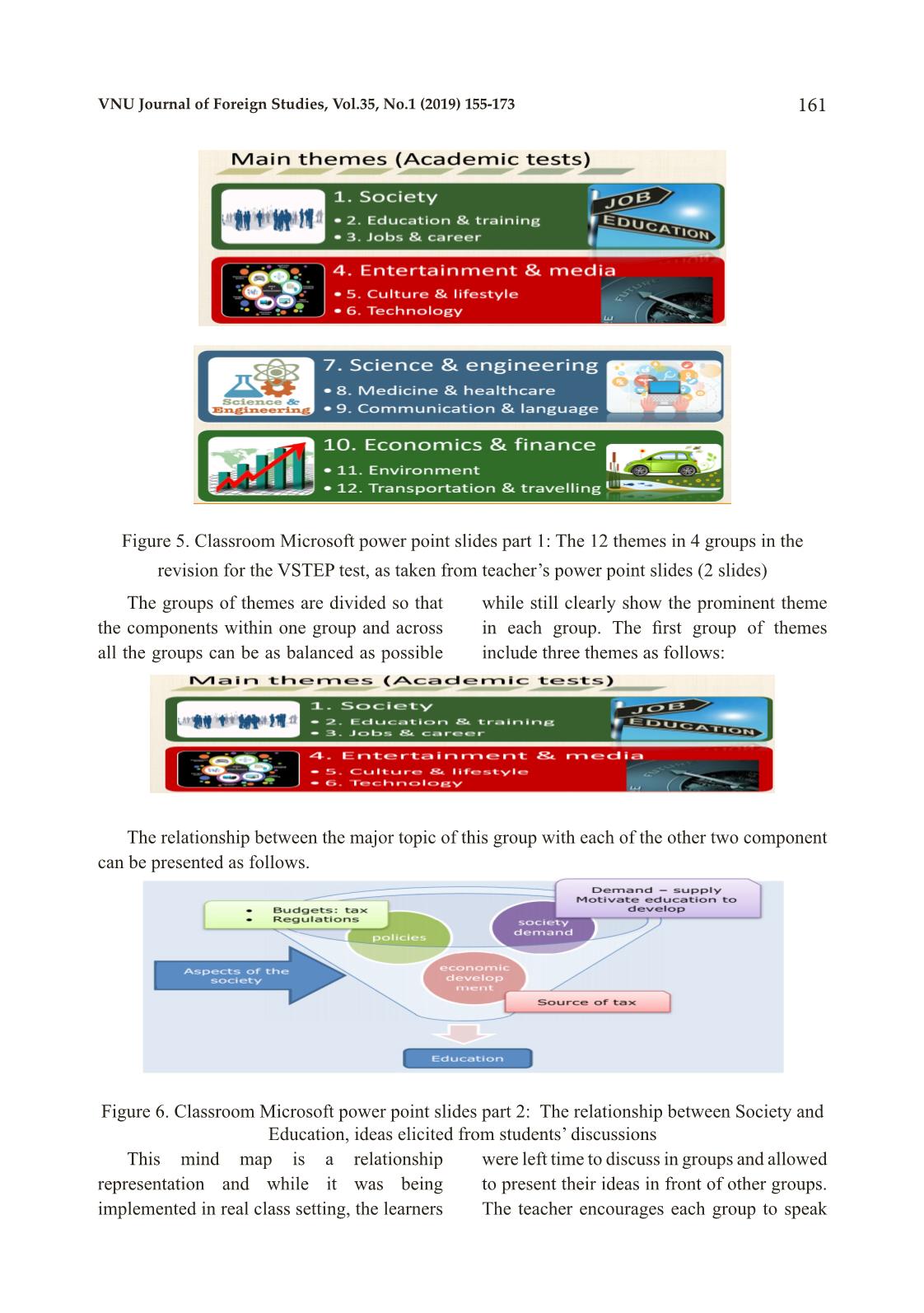
Trang 7
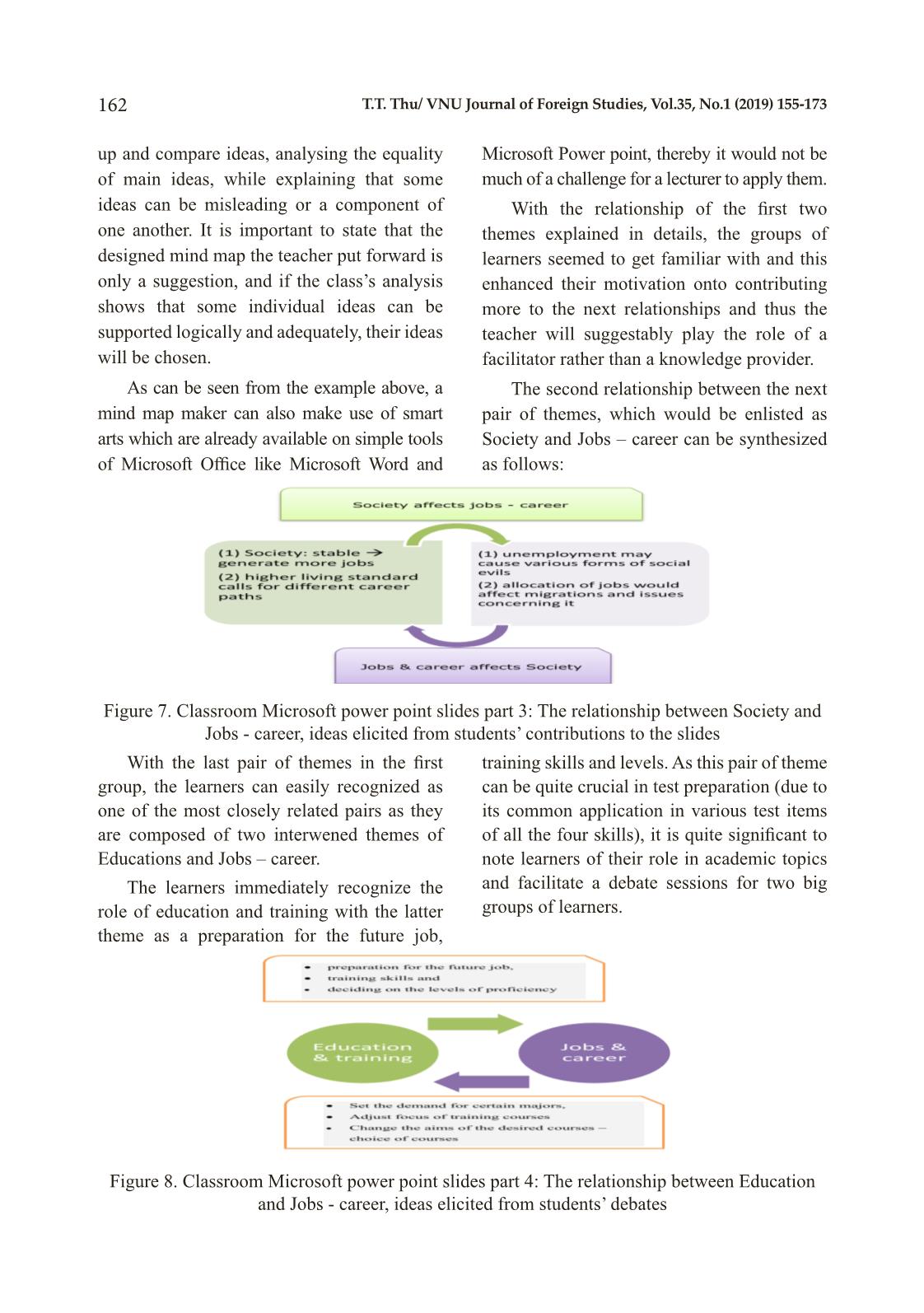
Trang 8
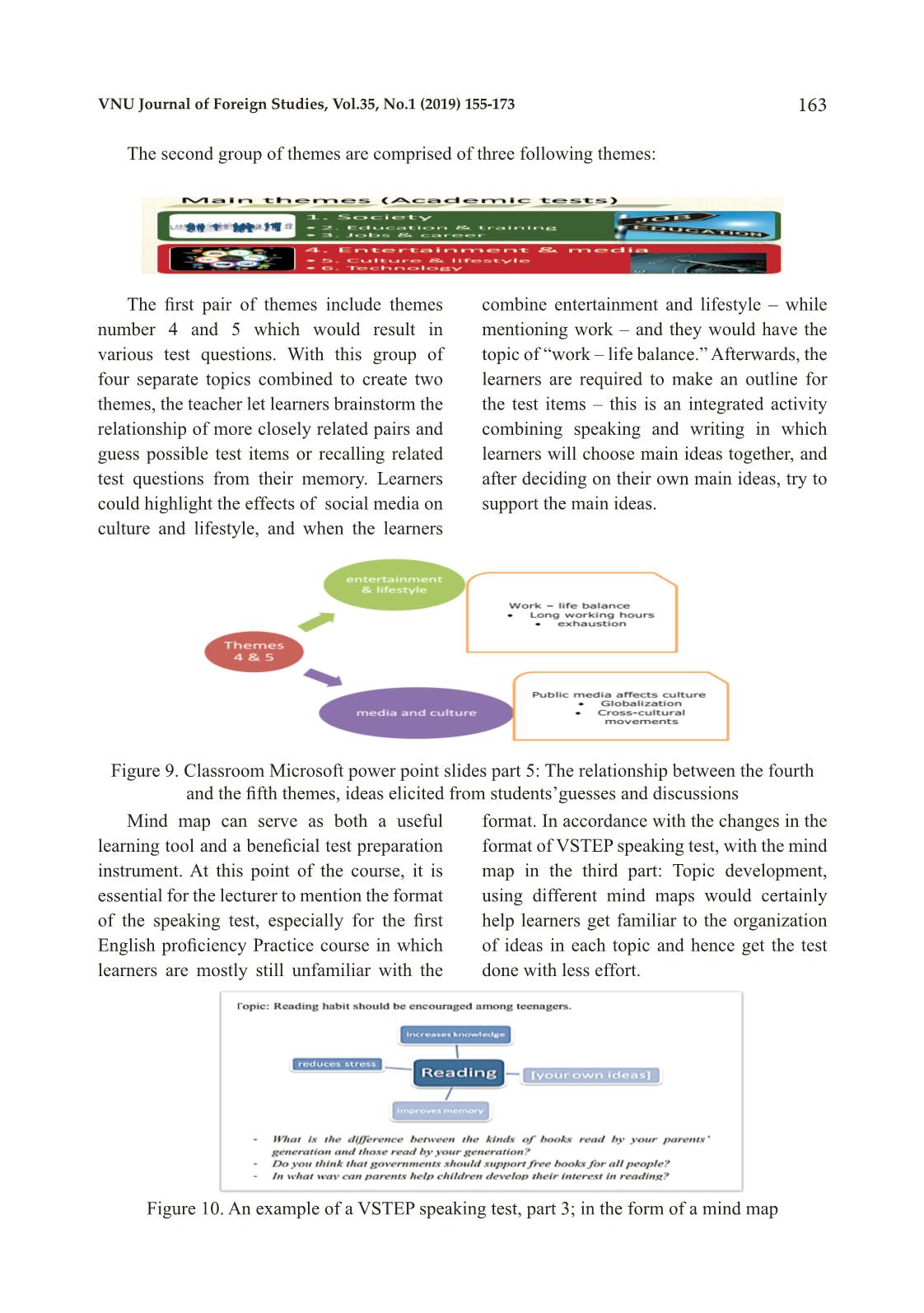
Trang 9
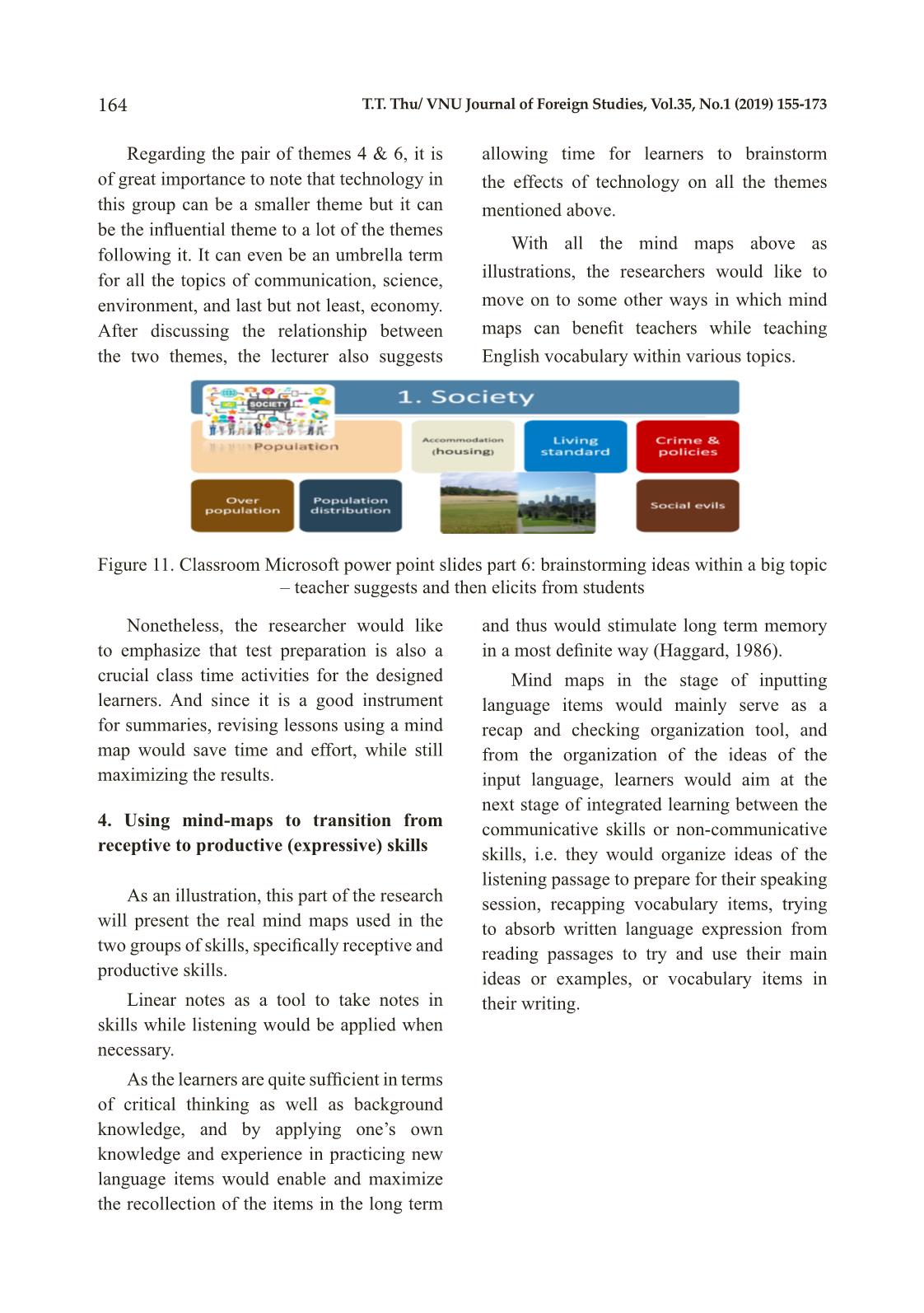
Trang 10
Tải về để xem bản đầy đủ
Tóm tắt nội dung tài liệu: Using mind-Mapping as a transition from receptive to productive skills for second - degree learners
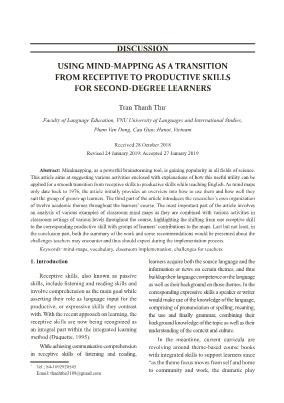
DISCUSSION USING MIND-MAPPING AS A TRANSITION FROM RECEPTIVE TO PRODUCTIVE SKILLS FOR SECOND-DEGREE LEARNERS Tran Thanh Thu* Faculty of Language Education, VNU University of Languages and International Studies, Pham Van Dong, Cau Giay, Hanoi, Vietnam Received 28 October 2018 Revised 24 January 2019; Accepted 27 January 2019 Abstract: Mindmapping, as a powerful brainstorming tool, is gaining popularity in all fields of science. This article aims at suggesting various activities enclosed with explanations of how this useful utility can be applied for a smooth transition from receptive skills to productive skills while teaching English. As mind maps only date back to 1976, the article initially provides an overview into how to use them and how well they suit the group of grown-up learners. The third part of the article introduces the researcher’s own organization of twelve academic themes throughout the learners’ course. The most important part of the article involves an analysis of various examples of classroom mind maps as they are combined with various activities in classroom settings of various levels throughout the course, highlighting the shifting from one receptive skill to the corresponding productive skill with groups of learners’ contributions to the maps. Last but not least, in the conclusion part, both the summary of the work and some recommendations would be presented about the challenges teachers may encounter and thus should expect during the implementation process. Keywords: mind-maps, vocabulary, classroom implementation, challenges for teachers 1. Introduction1 Receptive skills, also known as passive skills, include listening and reading skills and involve comprehension as the main goal while asserting their role as language input for the productive, or expressive skills they contrast with. With the recent approach on learning, the receptive skills are now being recognized as an integral part within the integrated learning method (Duquette, 1995). While achieving communicative comprehension in receptive skills of listening and reading, * Tel.: 84-1692920545 Email: thanhthu3108@gmail.com learners acquire both the source language and the information or news on certain themes, and thus build up their language competence on the language as well as their background on those themes. In the corresponding expressive skills a speaker or writer would make use of the knowledge of the language, comprising of pronunciation or spelling, meaning, the use and finally grammar, combining their background knowledge of the topic as well as their understanding of the context and culture. In the meantime, current curricula are revolving around theme-based course books with integrated skills to support learners since “as the theme focus moves from self and home to community and work, the dramatic play 156 T.T. Thu/ VNU Journal of Foreign Studies, Vol.35, No.1 (2019) 155-173 area may change from the familiar child and household furnishings (doll, kitchen, etc.) to office, restaurant, or grocery store furnishings and props (cash registers, typewriters, etc.).” (Berry & Mindes, 1993). For adult learners in general, they are expected to have more background knowledge as well as life experiences than young learners. Nevertheless, the groups of learners conferred here in the research would be more complicated as they belong to the group of adult learners among whom the majority have already acquired a university degree and purposely chose English as the major for their second degree. Furthermore, as they are studying for the second degree while doing their job or continuing another course at another university, it is crucial to maximize the efficiency of the methods of learning to help them achieve the aims and objectives of the course and hence aid them to reach level C1 - the required level of proficiency for their second bachelor degree. While acquiring adequate competency of advanced level is crucial, the groups of learners faced a lot of difficulties as not only do they have rather limited class time for their English major but they also face rather more limited acquisition of language items due to the mature age, as compared to younger learners. Though as mentioned above, they tend to possess the utmost advantages of life experiences and in-depth background knowledge across different fields of the current news and information, in many cases strong understanding of their previous majors. Before further discussion, a brief overview of the main concepts in the research would be discussed as follows. 1.1. Receptive and productive skills in language learning The two sets of skills requires (1) the encoding process in which the speakers or writers use the language to put forward their messages, using language items of their choice, and (2) the decoding process whilst the listeners or readers attempt to comprehend the messages or pieces of information basing on their own language competence and background. Nevertheless, the reversed order would customarily be applied in language learning process as the decoding process involving receptive skills would come before the encoding process with their corresponding expressive skills, i.e. the order of mentioning when discussing all the four language learning skills should be (1) listening – (2) speaking, then comes the pair (3) reading – (4) writing. Rather than aiming at readers as learners of the language, this section would aim at the side of the teachers/lecturers and hence focus on the terms and methodological notices during the teaching process. In order for a set of communicative objectives in a communicative curricula to be accomplished, “the objectives should be experiental in nature, that is, they should make use of students‘ life experi ... to memorize. With the particular group of adult learners who may also have a job and a family to take care of, it is best for them to maximize the efficiency and learn the items fast. In the picture above, the lecturer actually drew some fruits and even a coconut tree to help her learner memorize the items better. If other teachers are not as confident in drawing, it’s for the best to prepare flash cards to aid with the memorization. Figure 14. Picture of board mind map 2 – Fruits- elicited from learners learning the course of Level A2 – Pre-intermediate 168 T.T. Thu/ VNU Journal of Foreign Studies, Vol.35, No.1 (2019) 155-173 With the nature of this topic being the names of different kinds of fruit, it is useful to give learners a way to classify fruits, i.e. according to colors (ideas taken from the mind map on the internet, shown in the picture on the next page). The teacher then elicited learners’ vocabulary of the kinds of fruit they know and help them note on the board. Images or drawings also serve as motivators to encourage learners to study more efficiently. It is crucial that the learners get to contribute to the map, since a sense of contribution would also be another motivation. Moreover, when the teacher keeps on giving out the main ideas, and the details as well, the ultimate goal of a mind map of organizing own ideas would be left out. This is why the mind map has to be done on the spot while internet materials are available and ready to be used in the classrooms with projectors, all available in the university. Figure 15. A mind map from the internet to aid teachers while preparing for the lesson21 With proper citation, all these mind map can be of excellent use to revise quickly all the vocabulary items the learners already encountered or came up with in the first time, and it is inevitable that they have revision to enhance the introduced expressions for long- term memory build-up (Halliday, 2014). Figure 16. Picture of board mind map 3 - describe my new classroom - a writing activity of Descriptive paragraph1 2 Source: https://www.tes.com/teaching-resource /fruit-mind-map-6451788 169VNU Journal of Foreign Studies, Vol.35, No.1 (2019) 155-173 With this topic, the teacher had to aid learners with the key questions to ask about the topic. For some of the questions that learners could think of themselves, the lecturer instructed them to have a relationship among/between their ideas: chronological order, spatial order, causes – effects, or trying to sequence the ideas in a logical way. From this instant, it is useful to note that implementing this useful modern tool would mean a lot of hard work to the side of the teacher as not only do they have to prepare for a lot of materials and may have to search for ideas for categorization from other mind maps on the internet, they also have to master eliciting skills, which means dealing with, helping learners organize their random ideas into the map, explaining to them the reason why that particular supporting idea should belong to that idea, and may have to help them order the ideas most defi nitely immediately. Figure 17. Picture of mind map 5 – Family tree (drawn by a learner) in A1 Level - Elementary The result can be highly pleasing. The picture above is from a learner. Some of them can follow the instructor and draw very creative map which implies their high motivation in learning the language. The mind maps are integrated with images to motivate learners to study. With a normal setting in class, the following mind map can be a good example of a mind map made used of the white chalks and green board in all classrooms, which can be served as a substitute for the slideshows when there are technical problems. Figure 18. Board photo of activity in class (number 1): Eliciting and suggesting main themes for learners of Level B1 – Intermediate 170 T.T. Thu/ VNU Journal of Foreign Studies, Vol.35, No.1 (2019) 155-173 For instance, with a writing question with the test question: ‘What do you think of this statement: “People nowadays are more dependent on technology.”,’ the teacher asked learners to fi nd the key words and work together in small groups of 3 or 4 and discuss how they should develop ideas and add more vocabulary items on to the map. The following is a good example of a group who have done an excellent job. Figure 19. Board photo of activity in class (number 2): Writing skills: Group work for learners of Level B2 – Intermediate Figure 20. Board photo of a speaking activity in class (number 3): Writing skills: Group work for learners of Level B2 – Upper-intermediate In this activity, learners have an inquiry of matching their supporting ideas with the big themes the vocabulary items of which can be used in their speeches. The numbers 3, 4, 5, 6, 10, 12 can actually serve as suggestion for students of lower level: before they can come up with ideas, the teacher can suggest them think about the main themes they have learnt and try to connect the topics of the questions to the main themes. Figure 21. Board photo of a speaking activity in class (number 3): Writing skills: Group work for learners of Level B2 – Upper-intermediate 171VNU Journal of Foreign Studies, Vol.35, No.1 (2019) 155-173 Within the speaking lesson, this activity can actually be a good example of a test preparation one. The core mind maps are actually from a real speaking test, part 3, with the topic of “there are several reasons why people choose to live in a big cities”. This activity is a class activity with a student playing the role of the secretary. Anybody in the class can contribute, and the teacher would correct or make comment when necessary. Figure 22. Board photo of activity in class (number 3): Writing skills: Group work for learners of Level B2 – Intermediate This is an example of a mind map playing the role of the transition from Reading (a receptive skill) to Writing (the corresponding productive skill). Learners can make use of the language items they could remember from the previous activity and contribute to it using their own knowledge and experience. Relating to themselves was highly encouraging as can be observed in the classroom. With the kind of organization of comparing and contrast, it is benefi cial to note the students that they may have to face the same structures in all the four skills and it is safer to brainstorm a mind map so that they can organize their ideas better, as in VSTEP speaking test they also have one minute each to prepare for part 2 and part 3 of the test. As the ideas are so clear, the teacher here can play the role of a participants and allow the learners to have more freedom in deciding their ideas, suggestions and corrections may be provided afterwards as feedback. Figure 23. Board photo of activity in class (number 3): Writing skills: Group work for learners of Level B2 – Intermediate 172 T.T. Thu/ VNU Journal of Foreign Studies, Vol.35, No.1 (2019) 155-173 With the type of questions which require learners to compare two kinds of means of transport, the teacher may choose to suggest them focus on the nature of the subject (in this case ‘young people’). It can be seen from the picture that on the top they actually indicate clearly not only the key words but also the relationship among the items, using very good symbols. This table is also a form of mind map but its format was adjusted to fit the requirements of the lesson: choose the appropriate supporting idea for each main idea, indicating the appropriateness with arrows. 5. Conclusion This part of the article will demonstrate the summary and provide some suggestion for fellow teachers while applying this tool in their teaching. In applying the method to various groups of students of all the levels from A1 to C1, the question was not whether the teacher should make use of the useful tool; rather, it naturally shifted to the question of how should be applied in specific situations. The fourth part of this article was dedicated to achieve that. As beneficial as it is, when applying the tool to classroom setting, there are certain challenges for teachers throughout the process. First and foremost, they need to be prepared for all kinds of unexpected responses from their experienced learners and thus searching the internet in advance and constant build-up of background knowledge on various topics would be obligatory. Secondly, they may have to be ready for all kinds of questions, most of them concerning the reasons why they should put a supporting idea or an example into a branch of main idea. This requires high level of critical thinking and logic. Another challenge is the required flexibility and quick response from the side of the teachers. There are often more than 20 students in one group and the teacher has to elicit, analyze, select ideas, and organize them into the correct branches, while determining whether or not the learners could come up with proper main ideas, persuading them to use certain supporting details and not others. Though the tool can be rather challenging, applying them in real classroom setting can be very rewarding as it inspires both teachers and learners to be creative and thus stay motivated throughout the process. The reporter highly recommends the use of this useful tool in a large scale. References Amstrong, T. (2003). The Whole-brain Solution: Thinking Tools to Help Students Observe, Make Connections and Solve Problems. Ontario: Pembroke Publishers Limited. Berry, C. & Mindes, G. (1993). Planning a Theme- based Curriculum: Goals, Themes, Activities, and Planning Guides for 4s and 5s (pp. 10-11). New York: Good Year Books Publisher. Biggam, J. (2015). Succeeding with Your Master’s Dissertation. Ontario: Open University Press - McGraw-Hill Education. Buzan, T. (1974). Use your head. London: British Broadcasting Company Publisher. Buzan, T. (2018). Mind Map Mastery: The Complete Guide to Learning and Using the Most Powerful Thinking Tool in the Universe. London: Watkins Publishing. Candlin, C. N. (1988). Vocabulary and Language Teaching. London: Longman. Carter, A. & McCarthy, J. (2014). Vocabulary and Language Teaching. London: Routledge. Faculty of English, University of Languages and International Studies, Vietnam National University, Hanoi. (2015). Schedule for General English 1 (Semester I – Academic Year: 2015 - 2016). Green, F. (2015). Mind Mapping: Step-by-Step Beginner’s Guide in Creating Mind Maps!. Bloomington: Booktango Publishing. Guerrero, J. & Ramos, P. (2015). Introduction to the applications of mind mapping in medicine. Toronto: CreateSpace Independent Publishing. 173VNU Journal of Foreign Studies, Vol.35, No.1 (2019) 155-173 Haggard, R. (1986). The vocabulary self-collection strategy: Using student interest and world knowledge to enhance vocabulary growth. Journal of Reading, 29(7), 634–642. Hall, T., Milch, A. & McCormack, D. (2007). How to master skills for the TOEFL iBT Reading, Basic. Seoul: Darakwon Publishing. Halliday, M., & Matthiessen, C. (2014). Halliday’s Introduction to Functional Grammar. London: Routledge. Knowles, S., Holton, F., & Swanson, A. (1998). The adult learner: The definitive classic in adult education and human resource development. Houston Tex: Gulf Pub. Co. Lessard-clouston, M. (2013). Teaching vocabulary. English Language Teacher Development Series. California: TESOL International Association. Naqbi, S.A. (2011). The use of mind mapping to develop writing skills in UAE schools. Education, Business and Society: Contemporary Middle Eastern Issues, 4(2), 120 - 133. National Education Union. (2018). Fruit mind map. Retrieved from https://www.tes.com/teaching- resource/fruit-mind-map-6451788 Scott, S., Scott, D. E., & Webber, C. F. (2015). Leadership of Assessment, Inclusion, and Learning. New York: Springer Publisher. Suyanto, A. (2010). The effectiveness of Mindmapping to Teach Writing Skill Viewed from Their IQ (An Experimental Study in the Seventh Grade Students of SMPN 1 Prambon in the Academic Year 2009/2010). Graduate, Sebelas Maret University, Surakarta, Indonesia. The Peak Performance Center (2018). Mind mapping. Retrieved from com/educational-learning/thinking/mind-mapping/ Wahba, K., England, L. & Taha, Z. (2017). Handbook for Arabic Language Teaching Professionals in the 21st Century. London: Routledge. ỨNG DỤNG CÔNG CỤ SƠ ĐỒ TƯ DUY VÀO HỆ THỐNG HÓA CÁC YẾU TỐ TỪ VỰNG THEO CHỦ ĐỀ CHO HỌC VIÊN VĂN BẰNG HAI Trần Thanh Thư Khoa Đào tạo và Bồi dưỡng Ngoại ngữ, Trường Đại học Ngoại ngữ, ĐHQGHN, Phạm Văn Đồng, Cầu Giấy, Hà Nội, Việt Nam Tóm tắt: Sơ đồ tư duy, một công cụ hữu ích cho người học, đang ngày càng được ứng dụng rộng rãi trong nhiều ngành khoa học. Chính vì vậy, mục tiêu của bài viết này là chia sẻ các hoạt động áp dụng sơ đồ tư duy vào việc dạy từ vựng tiếng Anh. Trước tiên, bài báo sẽ có những giới thiệu tổng quan cách sử dụng sơ đồ tư duy cũng như cách áp dụng trong các hoạt động gắn với từ vựng. Bài báo sẽ trình bày cách chia nhóm đối với mười hai chủ đề lớn bao trùm nội dung trong chương trình học của học viên. Phần tiếp theo, cũng là phần quan trọng nhất, sẽ đưa ra những phân tích về các sơ đồ tư duy đã được sử dụng trong lớp học cũng như cách kết hợp chúng với các hoạt động cụ thể trong giờ học, qua đó, có những đề xuất để giải quyết các vấn đề mà người dạy có thể gặp phải trong quá trình áp dụng. Từ khóa: sơ đồ tư duy, từ vựng tiếng Anh, việc áp dụng trên lớp học, thách thức đối với giáo viên
File đính kèm:
 using_mind_mapping_as_a_transition_from_receptive_to_product.pdf
using_mind_mapping_as_a_transition_from_receptive_to_product.pdf

